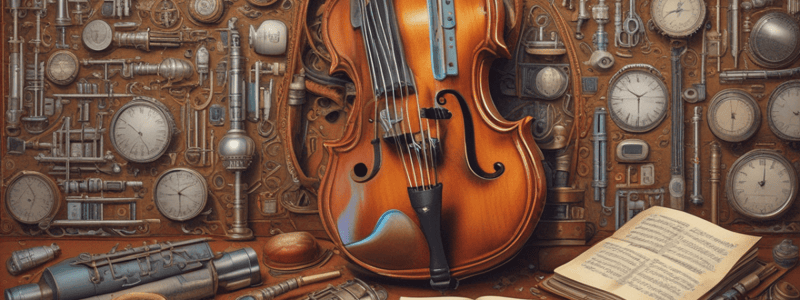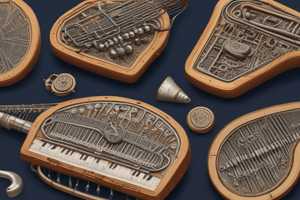Podcast
Questions and Answers
What is astronomical observation?
What is astronomical observation?
- Using advanced telescopes to study distant galaxies
- Observing the night sky with the naked eye
- Detecting observational values of celestial objects or a stellar event via bare eyes or technical instruments (correct)
- Measuring the properties of stars and planets
How did the German astronomer F.W.A. Argelander contribute to astronomical observation?
How did the German astronomer F.W.A. Argelander contribute to astronomical observation?
- He calculated the distances to nearby stars
- He discovered the first exoplanet
- He developed a technique for observing with the naked eye (correct)
- He invented the telescope
Which of the following is NOT mentioned as a method for astronomical observation in the text?
Which of the following is NOT mentioned as a method for astronomical observation in the text?
- Neutrinos
- Electromagnetic radiation
- Spectroscopic analysis (correct)
- Cosmic rays
What is the primary focus of the text?
What is the primary focus of the text?
Which of the following statements is correct based on the information provided in the text?
Which of the following statements is correct based on the information provided in the text?
Which of the following is NOT listed as a method for astronomical observation in the text?
Which of the following is NOT listed as a method for astronomical observation in the text?
What is the primary purpose of astronomical observation?
What is the primary purpose of astronomical observation?
Which of the following is NOT considered an observational value in astronomy?
Which of the following is NOT considered an observational value in astronomy?
What does the term 'proper motion' refer to in astronomical observation?
What does the term 'proper motion' refer to in astronomical observation?
Which of the following observational values is directly related to the chemical composition of a celestial object?
Which of the following observational values is directly related to the chemical composition of a celestial object?
Which of the following methods can be used for astronomical observation?
Which of the following methods can be used for astronomical observation?
Which of the following observational values is related to the temporal aspect of astronomical phenomena?
Which of the following observational values is related to the temporal aspect of astronomical phenomena?
What is the main purpose of this presentation?
What is the main purpose of this presentation?
Which of the following is NOT allowed with this presentation material?
Which of the following is NOT allowed with this presentation material?
What is the name of the course for which this presentation is prepared?
What is the name of the course for which this presentation is prepared?
Which department at Istanbul University is this course offered for?
Which department at Istanbul University is this course offered for?
What is the academic title of Can Güngör, the instructor for this course?
What is the academic title of Can Güngör, the instructor for this course?
Where did Can Güngör obtain his PhD degree?
Where did Can Güngör obtain his PhD degree?
What is the primary cause of light pollution?
What is the primary cause of light pollution?
How does light pollution affect migratory birds?
How does light pollution affect migratory birds?
What is the unit used to measure the brightness of the night sky in astronomical observations?
What is the unit used to measure the brightness of the night sky in astronomical observations?
Which of the following observatories has a better night sky brightness in the V band?
Which of the following observatories has a better night sky brightness in the V band?
Which of the following atmospheric effects can corrupt the quality of astronomical images?
Which of the following atmospheric effects can corrupt the quality of astronomical images?
What is the primary purpose of studying light pollution in astronomy?
What is the primary purpose of studying light pollution in astronomy?
What factor should be considered to ensure good observatory conditions in terms of aerosol size?
What factor should be considered to ensure good observatory conditions in terms of aerosol size?
Which characteristic of aerosol particles negatively affects telescope mirrors?
Which characteristic of aerosol particles negatively affects telescope mirrors?
What unit is used to measure aerosol concentration for observatory suitability?
What unit is used to measure aerosol concentration for observatory suitability?
Why is it essential for the Aerosol index to be lower than 0.5 in observatories?
Why is it essential for the Aerosol index to be lower than 0.5 in observatories?
Besides aerosols, what other factor should be considered when choosing the location for an observatory?
Besides aerosols, what other factor should be considered when choosing the location for an observatory?
How do aerosols contribute to light pollution in observatories?
How do aerosols contribute to light pollution in observatories?
Study Notes
Astronomical Observation
- Astronomical observation involves detecting observational values of celestial objects or a stellar event via bare eyes or by using technical instruments.
- Observational values include:
- Brightness (flux, count rate, etc)
- Colour (Spectrum)
- Position (RA, DEC)
- Proper motion, vertical speed
- Time
Bare Eyes Observation
- Argelander Technique was used by German astronomer F.W.A. Argelander (1799−1875) for observing celestial objects with bare eyes.
Electromagnetic Radiation
- Electromagnetic radiation includes:
- Neutrinos
- Cosmic rays
- Meteorites
- Gravitational waves
Light Pollution
- Light pollution is caused by scattered and reflected light from solid or liquid particles in the atmosphere, which obliterates the view of the night sky.
- It has adverse impacts on birds and other animals, such as disorienting migratory birds.
Choosing the Right Location for an Observatory
- Factors to consider when choosing a location for an observatory include:
- Altitude
- Meteorological conditions (cloudiness, clear sky counts)
- Absolute humidity, relative humidity
- Dust and Aerosol (solid or water particles in a gas with sizes smaller than 10 microns)
- Light pollution
- Average wind speed (and direction)
Studying That Suits You
Use AI to generate personalized quizzes and flashcards to suit your learning preferences.
Related Documents
Description
Learn about observational instruments and methods in the field of Istanbul University's Spring 2023-24 course. Please note that this presentation is intended for the education of Istanbul University Faculty of Science undergraduate students and should not be used as a scientific reference or for commercial purposes.




